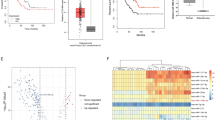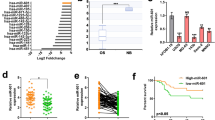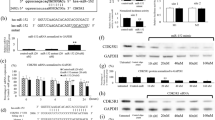Abstract
MicroRNAs (miRNAs) are important epigenetic regulators of gene expression. Although several miRNAs have been implicated in osteosarcoma, their role in regulation of osteosarcoma cancer stem cells (CSCs) remains unknown. Here we demonstrated that miR-26a is downregulated in osteosarcoma CSCs when derived by either sarcosphere generation, chemodrug or aldehyde dehydrogenase (ALDH) activity selection. Lentiviral overexpression of miR-26a in ZOS and 143B osteosarcoma cells decreases the expression of stem cell markers and suppresses sarcosphere formation, as well as ALDH activity. Moreover, miR-26a overexpression inhibits the tumor cell growth both in vitro and in vivo. We further demonstrate that miR-26a directly target Jagged1, one of the Notch ligand, and that its tumor suppressive effects are mediated through inhibition of Jagged1/Notch signaling. Importantly, reduced miR-26a expression, as determined by in situ hybridization in patient tumors (n=92), is associated with lung metastasis and poor overall survival of osteosarcoma patients. Together, these data suggest the essential role of miR-26a/Jagged1/Notch pathway in regulating the stem cell-like traits of osteosarcoma cells and provide a potential target for osteosarcoma therapy.
This is a preview of subscription content, access via your institution
Access options
Subscribe to this journal
Receive 50 print issues and online access
$259.00 per year
only $5.18 per issue
Buy this article
- Purchase on Springer Link
- Instant access to full article PDF
Prices may be subject to local taxes which are calculated during checkout








Similar content being viewed by others
References
Haydon RC, Luu HH, He TC . Osteosarcoma and osteoblastic differentiation: a new perspective on oncogenesis. Clin Orthop Relat Res 2007; 454: 237–246.
Kansara M, Thomas DM . Molecular pathogenesis of osteosarcoma. DNA Cell Biol 2007; 26: 1–18.
Siegel HJ, Pressey JG . Current concepts on the surgical and medical management of osteosarcoma. Expert Rev Anticancer Ther 2008; 8: 1257–1269.
Reya T, Morrison SJ, Clarke MF, Weissman IL . Stem cells, cancer, and cancer stem cells. Nature 2001; 414: 105–111.
Al-Hajj M, Clarke MF . Self-renewal and solid tumor stem cells. Oncogene 2004; 23: 7274–7282.
Adhikari AS, Agarwal N, Wood BM, Porretta C, Ruiz B, Pochampally RR et al. CD117 and Stro-1 identify osteosarcoma tumor-initiating cells associated with metastasis and drug resistance. Cancer Res 2010; 70: 4602–4612.
Mitra A, Mishra L, Li S . EMT, CTCs and CSCs in tumor relapse and drug-resistance. Oncotarget 2015; 6: 10697–10711.
Bartel DP . MicroRNAs: genomics, biogenesis, mechanism, and function. Cell 2004; 116: 281–297.
Shcherbata HR, Hatfield S, Ward EJ, Reynolds S, Fischer KA, Ruohola-Baker H . The MicroRNA pathway plays a regulatory role in stem cell division. Cell Cycle 2006; 5: 172–175.
Calin GA, Croce CM . MicroRNA signatures in human cancers. Nat Rev Cancer 2006; 6: 857–866.
Siclari VA, Qin L . Targeting the osteosarcoma cancer stem cell. J Orthop Surg Res 2010; 5: 78.
Artavanis-Tsakonas S, Rand MD, Lake RJ . Notch signaling: cell fate control and signal integration in development. Science 1999; 284: 770–776.
Bray SJ . Notch signalling: a simple pathway becomes complex. Nat Rev Mol Cell Biol 2006; 7: 678–689.
Engin F, Bertin T, Ma O, Jiang MM, Wang L, Sutton RE et al. Notch signaling contributes to the pathogenesis of human osteosarcomas. Hum Mol Genet 2009; 18: 1464–1470.
Radtke F, Raj K . The role of Notch in tumorigenesis: oncogene or tumour suppressor? Nat Rev Cancer 2003; 3: 756–767.
Pannuti A, Foreman K, Rizzo P, Osipo C, Golde T, Osborne B et al. Targeting Notch to target cancer stem cells. Clin Cancer Res 2010; 16: 3141–3152.
Li Y, Fan L, Liu S, Liu W, Zhang H, Zhou T et al. The promotion of bone regeneration through positive regulation of angiogenic-osteogenic coupling using microRNA-26a. Biomaterials 2013; 34: 5048–5058.
Tang QL, Zhao ZQ, Li JC, Liang Y, Yin JQ, Zou CY et al. Salinomycin inhibits osteosarcoma by targeting its tumor stem cells. Cancer Lett 2011; 311: 113–121.
Calcagno AM, Salcido CD, Gillet JP, Wu CP, Fostel JM, Mumau MD et al. Prolonged drug selection of breast cancer cells and enrichment of cancer stem cell characteristics. J Natl Cancer Inst 2010; 102: 1637–1652.
Chute JP, Muramoto GG, Whitesides J, Colvin M, Safi R, Chao NJ et al. Inhibition of aldehyde dehydrogenase and retinoid signaling induces the expansion of human hematopoietic stem cells. Proc Natl Acad Sci USA 2006; 103: 11707–11712.
Ginestier C, Hur MH, Charafe-Jauffret E, Monville F, Dutcher J, Brown M et al. ALDH1 is a marker of normal and malignant human mammary stem cells and a predictor of poor clinical outcome. Cell Stem Cell 2007; 1: 555–567.
Wang L, Park P, Zhang H, La Marca F, Lin CY . Prospective identification of tumorigenic osteosarcoma cancer stem cells in OS99-1 cells based on high aldehyde dehydrogenase activity. Int J Cancer 2011; 128: 294–303.
Takebe N, Harris PJ, Warren RQ, Ivy SP . Targeting cancer stem cells by inhibiting Wnt, Notch, and Hedgehog pathways. Nat Rev Clin Oncol 2011; 8: 97–106.
Esquela-Kerscher A, Slack FJ . Oncomirs - microRNAs with a role in cancer. Nat Rev Cancer 2006; 6: 259–269.
Fu X, Jin L, Wang X, Luo A, Hu J, Zheng X et al. MicroRNA-26a targets ten eleven translocation enzymes and is regulated during pancreatic cell differentiation. Proc Natl Acad Sci USA 2013; 110: 17892–17897.
Dey BK, Gagan J, Yan Z, Dutta A . miR-26a is required for skeletal muscle differentiation and regeneration in mice. Genes Dev 2012; 26: 2180–2191.
Salvatori B, Iosue I, Mangiavacchi A, Loddo G, Padula F, Chiaretti S et al. The microRNA-26a target E2F7 sustains cell proliferation and inhibits monocytic differentiation of acute myeloid leukemia cells. Cell Death Dis 2012; 3: e413.
Lian JB, Stein GS, van Wijnen AJ, Stein JL, Hassan MQ, Gaur T et al. MicroRNA control of bone formation and homeostasis. Nat Rev Endocrinol 2012; 8: 212–227.
Fujiwara T, Katsuda T, Hagiwara K, Kosaka N, Yoshioka Y, Takahashi RU et al. Clinical relevance and therapeutic significance of microRNA-133a expression profiles and functions in malignant osteosarcoma-initiating cells. Stem Cells 2014; 32: 959–973.
Di Fiore R, Drago-Ferrante R, Pentimalli F, Di Marzo D, Forte IM, D'Anneo A et al. MicroRNA-29b-1 impairs in vitro cell proliferation, selfrenewal and chemoresistance of human osteosarcoma 3AB-OS cancer stem cells. Int J Oncol 2014; 45: 2013–2023.
Song QC, Shi ZB, Zhang YT, Ji L, Wang KZ, Duan DP et al. Downregulation of microRNA-26a is associated with metastatic potential and the poor prognosis of osteosarcoma patients. Oncol Rep 2014; 31: 1263–1270.
Zeng YA, Nusse R . Wnt proteins are self-renewal factors for mammary stem cells and promote their long-term expansion in culture. Cell Stem Cell 2010; 6: 568–577.
Wang X, Liu J, Wang Z, Huang Y, Liu W, Zhu X et al. Periostin contributes to the acquisition of multipotent stem cell-like properties in human mammary epithelial cells and breast cancer cells. PLoS One 2013; 8: e72962.
Lin GL, Hankenson KD . Integration of BMP, Wnt, and Notch signaling pathways in osteoblast differentiation. J Cell Biochem 2011; 112: 3491–3501.
Tanaka M, Setoguchi T, Hirotsu M, Gao H, Sasaki H, Matsunoshita Y et al. Inhibition of Notch pathway prevents osteosarcoma growth by cell cycle regulation. Br J Cancer 2009; 100: 1957–1965.
Mu X, Isaac C, Greco N, Huard J, Weiss K . Notch signaling is associated with ALDH activity and an aggressive metastatic phenotype in murine osteosarcoma cells. Front Oncol 2013; 3: 143.
Tao J, Jiang MM, Jiang L, Salvo JS, Zeng HC, Dawson B et al. Notch activation as a driver of osteogenic sarcoma. Cancer Cell 2014; 26: 390–401.
Basu-Roy U, Basilico C, Mansukhani A . Perspectives on cancer stem cells in osteosarcoma. Cancer Lett 2013; 338: 158–167.
Zou CY, Wang J, Shen JN, Huang G, Jin S, Yin JQ et al. Establishment and characteristics of two syngeneic human osteosarcoma cell lines from primary tumor and skip metastases. Acta Pharmacol Sin 2008; 29: 325–332.
Lu J, Song G, Tang Q, Zou C, Han F, Zhao Z et al. IRX1 hypomethylation promotes osteosarcoma metastasis via induction of CXCL14/NF-kappaB signaling. J Clin Invest 2015; 125: 1839–1856.
Tang QL, Xie XB, Wang J, Chen Q, Han AJ, Zou CY et al. Glycogen synthase kinase-3beta, NF-kappaB signaling, and tumorigenesis of human osteosarcoma. J Natl Cancer Inst 2012; 104: 749–763.
Hopkins TG, Mura M, Al-Ashtal HA, Lahr RM, Abd-Latip N, Sweeney K et al. The RNA-binding protein LARP1 is a post-transcriptional regulator of survival and tumorigenesis in ovarian cancer. Nucleic Acids Res 2016; 44: 1227–1246.
Donnem T, Eklo K, Berg T, Sorbye SW, Lonvik K, Al-Saad S et al. Prognostic impact of MiR-155 in non-small cell lung cancer evaluated by in situ hybridization. J Transl Med 2011; 9: 6.
Zhang A, Hao J, Wang K, Huang Q, Yu K, Kang C et al. Down-regulation of miR-106b suppresses the growth of human glioma cells. J Neurooncol 2013; 112: 179–189.
Acknowledgements
This research was supported by National Natural Science Foundation of China (81272939 and 81472506 to JS) and Natural Science Foundation of Guangdong Province (S2013020012460 to JS). D-FL is the Cancer Prevention Research Institute of Texas (CPRIT) scholar in Cancer Research and supported by National Institutes of Health (NIH) Pathway to Independence Award R00 CA181496 and CPRIT Award RR160019. We thank Jingling Zhao (Sun Yat-Sen University) for expert technical assistance and Meghan Lambie (University of Toronto) for language editing.
Author information
Authors and Affiliations
Corresponding authors
Ethics declarations
Competing interests
The authors declare no conflict of interest.
Additional information
Supplementary Information accompanies this paper on the Oncogene website
Rights and permissions
About this article
Cite this article
Lu, J., Song, G., Tang, Q. et al. MiR-26a inhibits stem cell-like phenotype and tumor growth of osteosarcoma by targeting Jagged1. Oncogene 36, 231–241 (2017). https://doi.org/10.1038/onc.2016.194
Received:
Revised:
Accepted:
Published:
Issue Date:
DOI: https://doi.org/10.1038/onc.2016.194
This article is cited by
-
MiR-26a-5p as a useful therapeutic target for upper tract urothelial carcinoma by regulating WNT5A/β-catenin signaling
Scientific Reports (2022)
-
Noncoding RNAs: the shot callers in tumor immune escape
Signal Transduction and Targeted Therapy (2020)
-
Targeting cancer stem cell pathways for cancer therapy
Signal Transduction and Targeted Therapy (2020)
-
miR-26a promotes hepatocellular carcinoma invasion and metastasis by inhibiting PTEN and inhibits cell growth by repressing EZH2
Laboratory Investigation (2019)
-
MicroRNAs in Bone Metastasis
Current Osteoporosis Reports (2019)



